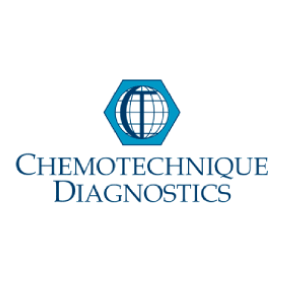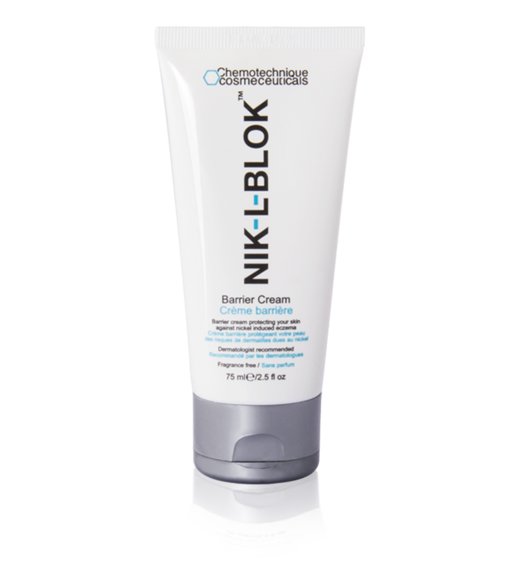Your nickel allergy doesn’t have to result in allergic reactions – let NIK-L-BLOK protect your skin.
In a world where we encounter nickel in our everyday lives through both objects and surfaces, avoiding nickel is extremely difficult. The best and most common advice that medical professionals have been able to give to their allergic patients up until now has been to “avoid nickel” in order to stay clear from allergic reactions. At Chemotechnique Cosmeceuticals, we are about to change this! Guided by the insight that even though nickel allergy is a chronic condition, allergic reactions are preventable, we are introducing our nickel barrier cream NIK–L–BLOK to the everyday skincare routine of allergic individuals.
NIK–L–BLOK is the world’s first patented, active barrier cream that encapsulates nickel ions, blocking them from penetrating the skin when in contact with metal objects. Active ingredients work effectively to protect the skin both internally and externally, preventing allergic reactions such as eczema, dryness, blisters, redness and itching to develop. NIK–L–BLOK is our contribution to an everyday life where the prospect of coming into contact with nickel is not a source of stress and anxiety.
Proudly introducing NIK–L–BLOK: the most innovative barrier cream on the global market.
NICKEL ALLERGY
When your skin is exposed to nickel, free nickel ions penetrate the outer skin layer (stratum corneum) and bind to skin protein. Sensitization (becoming allergic) to nickel occurs when the immune system treats the nickel bound in skin proteins as a threat, which happens when the accumulated exposure to nickel surpasses a critical threshold. This threshold varies greatly among individuals. Unlike most other types of allergies, contact allergies are not immediate but show delayed reactions, usually 12-48 hours after exposure. Once allergic to nickel, any exposure of nickel to your skin may result in an allergic reaction – Allergic Contact Dermatitis.
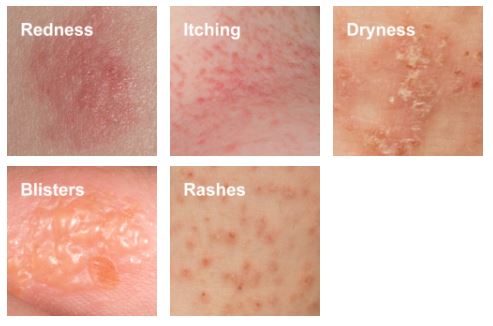
HOW NIK-L-BLOK WORKS
Nickel ions trigger allergic reactions only after having penetrated into the skin. NIK-L-BLOK is a revolutionary active skin barrier cream based on a patented chelating formula using the active ingredient DTPA to capture free nickel ions and block them from permeating the skin when in contact with metal objects. The cream’s ingredients work effectively to protect the skin both internally and externally, preventing allergic reactions such as eczema, dryness, blisters, redness and itching to develop. By using NIK-L-BLOK regularly on exposed skin areas, sensitization towards nickel will be prevented while your skin remains protected against nickel induced eczema. NIK-L-BLOK is the result of many years of dermatological research and clinical testing. Our patented formula serves as a testament to its quality and innovation.
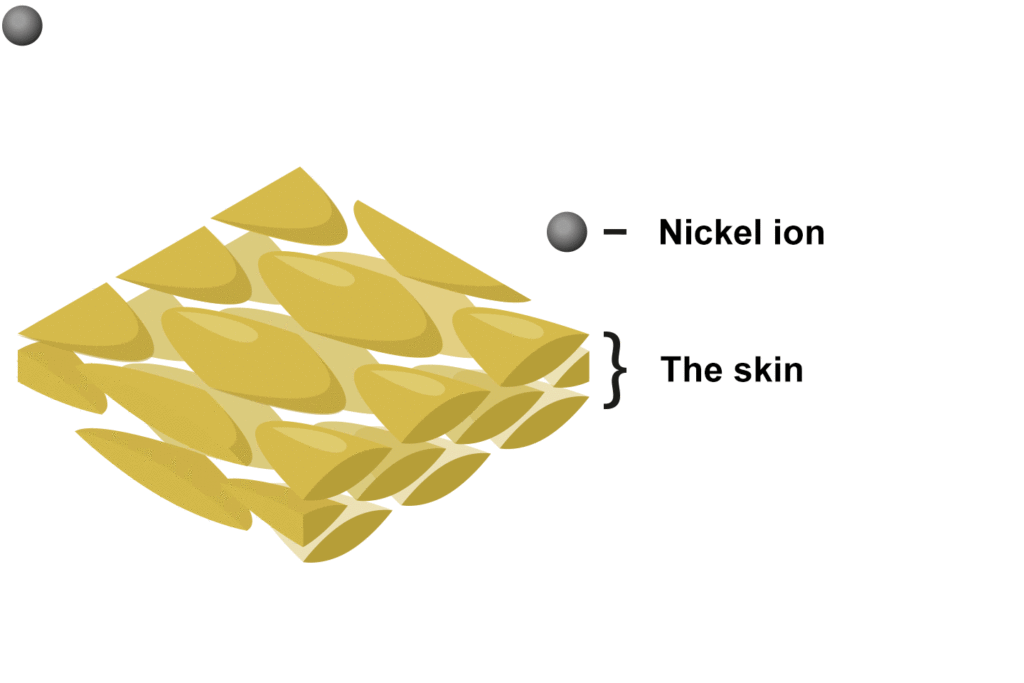
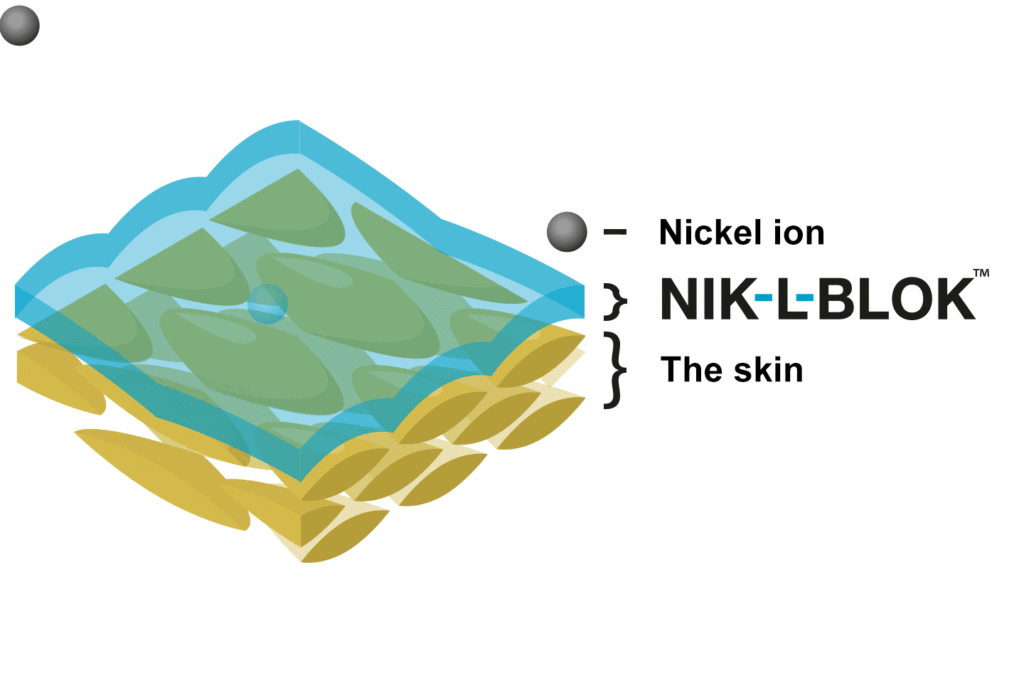
A DERMATOLOGIST’S PERSPECTIVE
We let one of the leading authorities on contact dermatitis, Dr. Radoslaw Spiewak* share his medical input on nickel allergy and why NIK-L-BLOK works so effectively in protecting skin from allergic reactions:
*M.D., Professor and Head of Department of Experimental Dermatology and Cosmetology, Jagiellonian University Medical College, Krakow, Poland
What is allergic contact dermatitis?
“Allergic contact dermatitis is a chronic or recurrent skin inflammatory disease which is caused by allergic reaction of the skin to small molecules (so called haptens) that enter the skin. The majority of people would tolerate the molecules without any symptoms, whereas people who are allergic (hypersensitive) to it will develop inflammation in the skin, which manifest as dermatitis (eczema).”
How do you get allergic contact dermatitis from nickel?
“First, you have to develop an allergy to nickel. In order for someone to become allergic, a number of factors must be in place, which we do not fully understand yet. However, early body piercing and the presence of other inflammatory skin diseases are known to increase the risk of developing contact allergy to nickel. Once allergic, there is little chance of getting rid of the allergy. The only way to keep healthy is to avoid contact with nickel, which may be tricky at times.”
What are common triggers that elicit eczema?
“In our daily life, there are many metal objects that may release nickel from their surfaces, e.g. coins (including Euro, British Pound, Polish Zloty etc.), tools and appliances like scissors, tweezers, sowing needles, door handles, handles on busses and tramways, key, chains, belt buckles, buttons, zippers, rivets on the garments, clasps, breastpins, spectacle frames, hairpins, stationery, stainless cooking pots, cutlery, fashion jewelry and many others. Electronic devices like laptops or mobile phones may be in metal encasing or they may have decorative elements of metal. The so-called “Nickel Directive” puts limits on nickel released from metallic objects that come into close and prolonged contact with the skin, however, there are still many objects in our surrounding that release nickel. Moreover, keys or coins (incl. Euro) are not considered to be objects in prolonged contact with the skin.”
How do you know if you’re affected by nickel allergy? What are common symptoms?
“The most typical symptom is itchy skin inflammation (eczema) developing in places where metallic objects are touching the skin for a prolonged time (hours, days). Typical examples are redness and swelling on earlobes after putting on earrings or ear clips, or itchy rash on the belly caused by metal buttons in jeans or belt buckles. Another may be dermatitis of the temples in the area where the spectacle frame touches the skin.”
What is a skin barrier cream? What is the difference between a regular barrier cream and one containing an active principle, i.e. a chelating compound?
“Haptens trigger allergic reactions only after penetrating into the skin. Skin barrier creams are intended to prevent the penetration of haptens into a sensitized person’s skin. This may be achieved by creating a layer which is impermeable for the haptens (passive barrier, i.e. regular barrier cream). This idea only works when the entire barrier remains intact, which is quite difficult to achieve. On a skin that is stretched and squeezed due to body movements, such a barrier will eventually break letting haptens in. Active barrier creams contain agents that bind the haptens so that the resulting compound is not capable of entering the skin (e.g. it is too big to permeate the outer layers of the skin). Such binding agents are called chelators. Ideal chelators should bind the nickel ions irreversibly, i.e. under physiological circumstances not release the free ion form that might enter the skin.”
How is NIK-L-BLOK’s patented formula using DTPA effective in preventing allergic contact dermatitis from nickel – and protecting already sensitized skin?
“A cream with a strong chelating substance (DTPA) is effective in capturing nickel and also cobalt ions, thereby hindering them from reaching the skin and causing allergic contact dermatitis. This effect could be used for protecting nickel-allergic persons from recurrence of eczema after contact with nickel releasing objects, but also for the prevention of developing contact allergy in non-sensitized persons exposed to nickel.”
What makes NIK-L-BLOK innovative as an everyday aid for nickel allergic patients?
“NIK-L-BLOK has a unique formulation, that gives a nickel allergic person a better chance to live an eczema-free life without anxiety of accidentally coming in contact with nickel releasing objects.”

